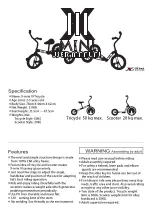
74
75
GEARS
THE GEARS
The gears on your Canyon serve to adjust your pedal-
ling power to the slope of the road, wind conditions,
and the desired speed. The gears do not reduce the
physical work to be performed which remains the
same with the identical distance to be performed at
identical speed, but the pedalling force per crank ro-
tation. In other words: A low gear allows you to climb
steep hills with moderate pedalling force. You have to
pedal, however, relatively fast.
Downhill you switch to a high gear. Every turn of
the pedals takes you many metres forward at corre-
spondingly high speed. To ride economically you fre-
quently have to switch gears. As with a motor vehicle,
your „engine” wants to be kept within a certain speed
range, if it is to give its best performance.
On level ground your pedalling speed, also referred to
as cadence, should be higher than 60 strokes a min-
ute. Racing cyclists pedal at a rate between 90 and
110 strokes a minute on level ground. When climbing
uphill, your cadence will naturally fall off somewhat.
Your pedalling should always remain fluent however.
Finely graduated adjustments as well as an easy op-
erability of modern bike gears are the best precon-
ditions for an efficient riding. In addition, it reduces
chain and sprocket wear as well as the strain on your
knee joints.
Derailleur gears are the most effective type of trans-
mission on bikes. About 97 to 98 percent of the
pedalling force performed is transmitted to the rear
wheel with well-maintained and greased derailleur
gears. The control of the gear system as well as the
braking performance leave nothing to be desired.
With specially designed sprocket teeth, flexible
chains and clearcut lever positions, shifting gears
has become very easy.
Derailleur gears
Rear derailleur
!
Always wear straight-cut trousers or use
trouser clips or the like to make sure your
trousers do not get caught in the chain or chain-
rings, throwing you off your bike.
Front derailleur
The brake models of some manufacturers include
transport locks with cut-outs. The brake pads of
these brakes must be replaced as soon as they fit into
these cut-outs.
Only use original replacement pads and follow the
operating instructions of the brake manufacturers. If
you have the slightest doubt, leave this job to a skilled
mechanic.
Brake pads
i
New brake pads have to be bedded in
before they reach their optimal braking
performance. Accelerate your Canyon 30 to 50
times to around 30 km/h (18 mph) and bring it to
a halt each time.
i
For more information visit the following
websites:
www.formulabrakeusa.com
www.formula-brake.it
www.magura.com
www.paul-lange.com
www.sram.com
i
With the wheels dismounted, do not
actuate the brake levers. This would cause
the brake pads to be pushed together, making
it difficult to remount the wheel. Mount the en-
closed transport locks after dismounting the
wheels.
Do not transport your Canyon with saddle
and handlebars upside down – risk of
brake failure.
i
In any case, be sure to read the original
instructions of the brake manufacturer be-
fore adjusting the brakes.
BRAKE SYSTEM
DISC BRAKES
















































